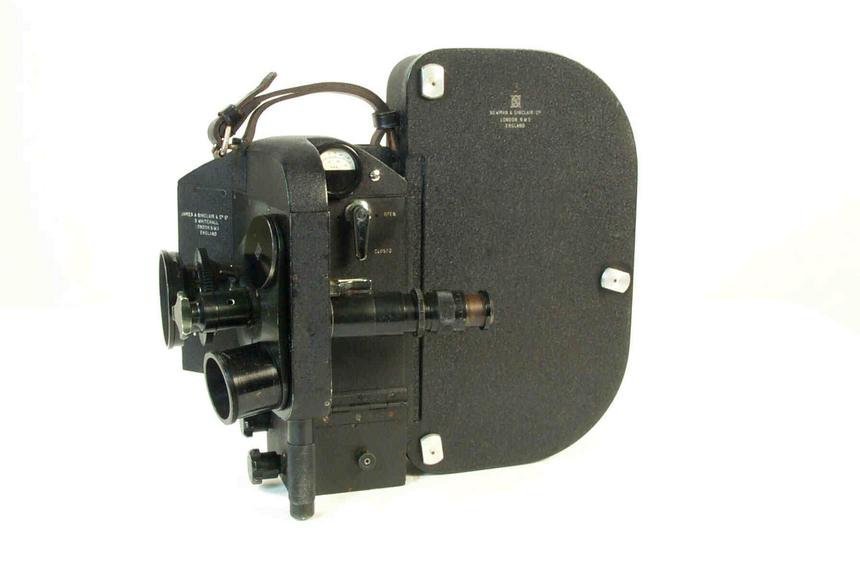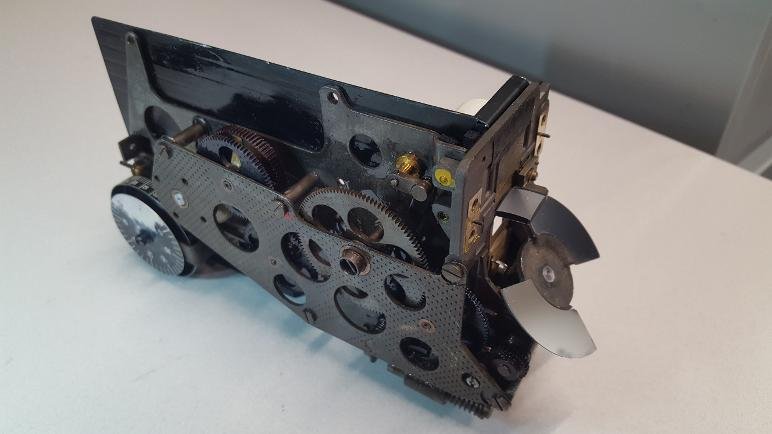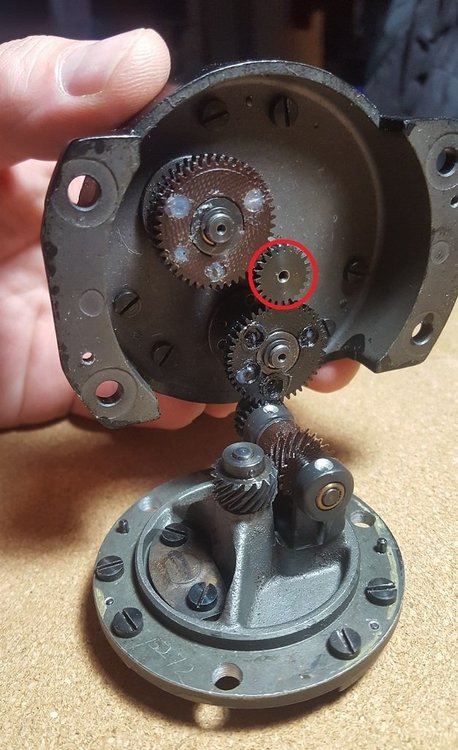-
Posts
301 -
Joined
-
Last visited
Everything posted by Gareth Blackstock
-
So I came across this cine camera, quite a big thing, in a second hand shop. The shop owner initially told me the camera was off the floor, being stored in a private room. I seemed pretty keen, I thought it might be an old Auricon, he told me the camera was an old newsreel camera. He eventually took me upstairs to see the camera. From the distance I thought it was an Eclair, but getting closer it seemed to big. Anyway, turns out to be a pretty good condition Newman and Sinclair NS400. The attached picture is not of the actual camera, its from the net. The camera in the shop came with around 5 lenses and a magazine. Does anyone have any info on these cameras? Any documents? The shop owner seems keen to power it up, but I warned him off until he knows exactly what voltage etc is needed, otherwise he risks killing the motor. And the price tag is AUD$3600... Cheers, Gareth
-

16mm Camera Battery Pack Designs with Replaceable Cells
Gareth Blackstock replied to Kamran Pakseresht's topic in 16mm
Hello, These are very cool, nicely designed too. I have been lugging around a heavy 12v motorcycle battery in a camera case for when I need a power source. Have you considered putting a couple on one of the popular auction sites? Not necessarily to sell, but to let the google bots find the listings and make it very easy for a film maker/tinkerer to source your battery packs? I like the voltage regulator idea, it does away with making a d.i.y supply for each camera one owns that have different voltages. Gareth -
Hello, Aapo I can appreciate where you are coming from... but I have too many cameras for the very small amount of film I shoot... I am trying hard not to become a home for 'lost cameras' that no-one else wants... And diverting time from my other projects to mount motors onto Kievs..... I have to prioritise... And I really do not think in Australia at the moment that I could even get $150 for a nice working Kiev... and I dont think film students down here use cine cameras as part of their studies... I might be wrong though.. and although I have 5 cameras, I only have two sets of lenses. The Kiev 16U lenses have been widely bought up in the last 15 years by stills photographers.... they are pursuing the fabled 'bokeh' characteristic of old soviet lenses. Some would think chasing lenses with imperfections a strange pursuit, but many of those lenses have nice qualities.... The annoying part is it seems almost every old Kiev lens get very very stiff due to the ageing grease, so either the seller gets them over-hauled, which adds more to the cost, or they sell them in 'as is' condition, after which the buyer gets stuck with the stiffest lenses imaginable... Gareth
-
Hello, Sebastian Thanks for the awesome feeback on my efforts with the Kiev 16U. I also created a sister site with updated info on the Kiev, plus an English manual I translated... here is the site: https://aussiecine.wordpress.com/using-16mm-film/ I hope you have lots of good shooting with the Kiev. When researching the Kiev I visited LOTS of websites and old chat groups, there was an interesting opinion I found: some cameras that suffer soft focus regardless of lens use or adjustment, may actually have incorrect flange distance. This is a hard measurement to make, let alone adjust. A camera tech is best for this one. These cameras reportedly offer excellent results consistently. It is always good to hear my efforts on the repair sites have helped another camera get back into service, Cheers, Gareth
-

A processing machine up for auction...
Gareth Blackstock replied to Gareth Blackstock's topic in Film Stocks & Processing
So just a quick update, the processor is working well and I am within 3 to 5 months of going to be able to process some film. I still have a few items to adapt, a blower heater for the drying cabinet, and working out the temps so I don't cook film. The vacuum process is pretty much sorted, and I will install an extra roller in one of the racks, should assist the film going through the processor better. And once I process some film I may have to adjust a few things depending on the results. I have run the processor to establish times for development etc. It take an hour to feed the leader through from start to finish, so if I attached some 400 ft exposed film to the tail, it would take another hour to process that... so 2 hours... when they told me it was a slow B&W processor they weren't joking! Power supply is stable, a 3 phase generator with an extension.... Before doing any processing everything needs a good clean, and I have to make up a cover for the whole processor to protect it from dust etc. Thankfully it is a small processor, maybe 10 feet in length. I have also received lots of positive support from local film processors and experienced people, and suggestions like modifying it to run colour film.... not sure about that one, sounds to be very difficult... I also keep a regularly updated blog of my progress, with pictures and videos of the processor: https://aussiecine.wordpress.com/filmlab-engineering-bw-processor-blog/ Gareth -

A processing machine up for auction...
Gareth Blackstock replied to Gareth Blackstock's topic in Film Stocks & Processing
Ha Ha.... yeah... next I'm bringing back 8 track! Well the processor was ear marked for the scrap heap, and I would hate for a good machine to go to waste... much like the 16mm cameras I like to repair... And I love to tinker... -

A processing machine up for auction...
Gareth Blackstock replied to Gareth Blackstock's topic in Film Stocks & Processing
Hello, So I have been working slowly but steadily on the processor, I have been adjusting the rollers, currently replacing some perished roller tires, and continued working on disconnecting some heavy draw motors and will later replace with lower voltage motors. I purchased a 3 phase petrol generator and the processor runs on it very well. Although I think I am still around 5 months from getting close to experimenting processing some film in caffenol, I may still come across obstacles. I created a blog so I could add pics and explanations as I go. https://aussiecine.wordpress.com/filmlab-engineering-bw-processor-blog/ getting there slowly.... Cheers, Gareth -

Cable for Konvas Crystal Sync Motor
Gareth Blackstock replied to Geffen Avraham's topic in Russian Gear
Actually search for another member here, Aappo... he builds motors for Russian cameras... -

Cable for Konvas Crystal Sync Motor
Gareth Blackstock replied to Geffen Avraham's topic in Russian Gear
The two links below might be a good start: http://konvas.org/faq/faqs/faq And this one deals with re-wiring to an XLR connector. http://konvas.org/faq/faqs/faq/konvas-17ep-and-19ep-motor-power-requirements If need be you could always remove the casing and examine the wiring, following the wires to an earth or others to capacitors etc should be easy to recognise. -
Hello, I recently took apart another Kiev 16U, this one was very noisy. I recorded the racket it made before, and recorded it again after, the difference is quite stark. Almost 10Db quieter. One should also remember that by strapping the smart phone to the tripod leg would add a few Db as well from vibration... but I simply wanted to see the difference before service and after. With lenses inserted and testing from 5 feet away, I reckon the 16U would be acceptably quiet for most shooting needs.
-
So I was lucky enough to get hold of a few of these interesting 16mm cameras. Built between the late 60's and mid 80's (?) they seemed quite interesting to read about. Of the cameras I bought only one was working, very loudly and with fluctuating speeds. Taking them apart I considered the build quality to be pretty good, easy to get to everything, seemingly basic design but well executed I think. I immersed the clockwork gears in a sonic cleaner, which did an amazing job. Then a light lubricate and reassembly, and I was quite surprised to hear it literally "purr" I added the photos and process to my website, hopefully if future film enthusiasts find such a camera they can easily find some information on it. https://canon-s8-repair.yolasite.com/Kiev-16U.php https://canon-s8-repair.yolasite.com/kiev-16ue.php Cheers, Gareth
-
Hello, I am based in Ballarat, Victoria. I bought a CP 16R around 3 years ago for $350 that needed a good service and it's rubbers replaced. The camera also had a cool history, used by a photojournalist in the 80's to cover the middle east and he saw a fair bit of action. Sadly I think in this end of the world such cameras go very cheaply... there is not as much interest as there is in the northern hemisphere. If it is for display, at least you can assure the owner it will not be discarded but kept safe. If the lens is a notable one, perhaps it's value may be higher, but not many people shoot with CP's anymore and the lens mount is unique. Limiting potential buyers. What provenance by the way? Gareth
-
Well Simon, you undoubtedly know more of the Pentaflex than myself, it is very rare I take a vernier to a camera as I lack service manuals and specialised servicing tools, most often I have to find my way and attempt to detect how things work. It is interesting what you say about it's design origins and contemporary camera developments. And yes, the camera is certainly an ugly ducking. It makes me wonder if the designers tried really hard to make a boxy, poorly balanced, over weight camera or they simply had no plastic available for manufacture, so steel was it. The following is a quote from http://www.lusznat.de/cms1/index.php/kinomuseum-muenchen/gerhard-fromm-s-sammelblaetter/ak-16-pentaflex-sammelblatt “She is really not beautiful, she is not small either, as a lightweight one can cannot say, nor running-quietly, …was produced in the early 50s. Clean mechanics, the camera and the motors are beautifully crafted … are from the Pentaflex 16 program and stand out in terms of workmanship and appearance. When the name changed around 1960, the look of the camera was also changed. Instead of leather, a matte-greyish plastic and elastic material was used and the camera was painted in grey hammered finish… A loud camera that seems neither suited for hand-held or on-the-shoulder, just designed for a tripod. An unwieldy black box, so to speak, where you can start one of the even more unmanageable motors at the bottom or right side and insert a cassette at the top” However, while the camera in your opinion is poorly developed, poorly designed, poorly appointed with a turret instead of single mount, and poorly machined, I believe the camera exemplifies norms of the time in East Germany and the Soviet Union. A time when few industries had advanced R&D, had difficulty accessing modern materials, and likely had workforce's plagued with little motivation to do more than the minimum, I think these cameras are diamonds in the rough, what they lack in bells and whistles, they make up for in their indestructibility... If you drop one, it'll keep working, they will run in freezing conditions, can be operated by anyone, and are not plagued by circuitry boards that oxidise... don't rely on computers and can run on a motorcycle battery.. and I think for the amateur film maker, these types of 16mm cameras are ideal, cheap, easy to repair, high quality standard lenses, and very robust.... all for less than $250 in any currency..... "They're boxy, but they're good" era is certainly an ugly d,
-
Hello, I have included some links below, the Auricon optical sound group is the best bet, Jack is there too. Auricon Optical Sound group: https://groups.io/g/AuriconOpticalSound A web site devoted to all things Auricon, very active, helpful members, a wealth of knowledge regarding using Auricon cameras in the modern age. Wikipedia Page: https://en.wikipedia.org/wiki/Auricon A wealth of information on the Auricon cameras and history of the factory. Milton David Holmes Auricon site: https://sites.google.com/site/mdavidholmes/auricon-16mm-cameras A must visit to learn about the Auricon cameras and history.
-
Thanks for the fibre info, Dom. Very helpful. Regarding the printed cog I will be running the camera with a load of film and also at high speed as I am now curious to see how well the printed gear will manage. The first batch of gears I ordered came back with a bind point, and after investigating the issue, I realised the original fibre cog I sent to be copied had the bind point. The second batch is better. Cheers, Gareth
-
Another question for Simon: I am curious about your statement on the Pentaflex maintenance requirements. The Pentaflex has one maintenance oil port, coloured red, accessible from the outside of the camera. In the inside of the camera there are more, not coloured though. As far as I am aware, older cine camera makers required owners to occasionally maintain or at least apply lubricant to their cameras, in specific holes only, usually coloured red. I took a picture of the oil route holding the motor mounts as they would be on the camera. The cog circled in red is the one that has an oil maintenance hole. So I think here you are correct, that oil from the maintenance hole will eventually flow down to the bottom cog, but I think more as a side benefit, not an engineered design. Also, after having used my Pentaflex a few times, certainly running it without film, I have not seen any oil travel up the cog system. I would have noticed a change in colour of the FRC cog. To get oil to travel upwards, you need either a different viscosity or a "sticky" oil. Also, there are many areas of the camera's internals that are entirely free from any lubricant, and there is no evidence of dried old grease. Nor is there build up of oily dust. I consider that as these cameras were very expensive in their day, and well made, that if they were intended to be fully lubricated, then I would see some evidence of it. I have opened a few old cameras and found lots of old built up lubricant. This is from a Pentaflex 16mm user manual I translated ages ago "The camera, engine and cassette oiling is required by the manufacturer or the authorized repair shops after 50 operating hours. The camera drive is provided with non-resinous, low viscosity, cold-resistant oil. For this, a few drops are sufficient." I am inclined to believe that the Pentaflex was designed to be a dry running camera, oiled only via maintenance hole, and if during a service, then only the cog area. If you have access to a Pentaflex service manual I would be keen to hear what it dictates. perhaps to allow cine cameras to be used in cold climates, lubricants were minimally applied to prevent the lubricant freezing.
-
Well there is some pretty good info here, thanks guys. I have a couple of questions though- For Simon: Which Bell & Howell design or camera was the Pentaflex copied from? I was under the impression that it was quite a unique design.
-
Thanks for the added info Simon, what type of oil would have been used? Or would it have been a grease? Although the camera gears and cogs I have show no wear, I would be interested to see what lubricant can be used... I am unsure why the Pentaflex has these types of cogs/gears, I doubt the factory would want to keep the weight down, they already weigh a ton... and there are plenty of metal cogs/gears in the camera... Odd. Gareth
-
Thanks for the feedback, I'm curious Simon, what is the name of the cog's material? I acknowledge Bakelite is a harder type of material, but it's a lot easier to say than "fibre-reinforced composite" I think regarding the lubrication of the gear train, that you are mistaken with the Pentaflex. Early East German industries utilised numerous materials, I never took time to research the various ones. Sometimes I imagine they used whatever was available.... and cheap. Judging from the inside of the camera, there is only 3 lubrication points, all spindles. The fibre-reinforced composite cogs all appear to run dry. There is evidence from the metal cogs in the camera that they likely had a light smear of grease applied, but these cog do not contact the fibre-reinforced composite cogs.
-







.thumb.jpg.54d0643daa2e423699a4efe95efa80d0.jpg)

